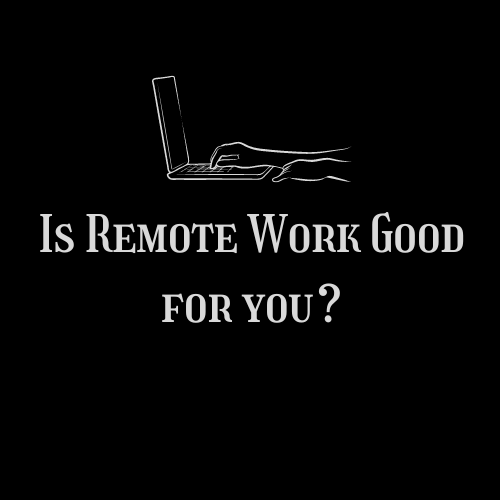

Change is the only constant in this world. The year 2020 brought drastic changes propelled by Covid. Ranging from wearing masks to how we work. Remote work became the new norm due to safety and well-being concerns. Ever since, some organizations have embraced that style of work. If you are considering remote work, researching it, or struggling because it impacts your health and well-being, then you are at the right place. In this short essay, I will try to present various aspects of remote work.
Remote work, commonly called work from home, is an arrangement where employees conduct their job tasks from a location outside of the traditional office environment (Gartner, n.d.). This setup enables individuals to work remotely from home, utilizing digital tools and technology to remain connected with colleagues and complete work assignments. This essay addresses how to bear the burdens of remote work effectively, but first, let’s look at its blessings:
Time flexibility: There is absolutely no rush to get to work. Employees can get up at a decent hour and spend their time in meditation, workouts, or a positive morning routine instead of hustling in a road rush.
Comfort: House is the most comfortable place for anyone. Working from home creates a sense of comfort from heat/cold and other discomforts. It also provides a sense of safety from various dangers such as road accidents, attacks from flawed individuals and animals, etc.
No traffic torture: Remote work means saying goodbye to traffic lights, jams, accidents, etc. Why take a quick bite and grab a cup of coffee? Enjoying your meals while sipping a hot cup of coffee while reclining on your couch are some of the luxuries of remote work.
That sounds a 100% win win situation! But, I would advise you to see the flip side before jumping the gun. Read a little more and consider the following drawbacks:
Feeling isolated: The biggest drawback of remote work is the lack of human connection. We are gregarious beings. Although we can share information through virtual interactions on a computer screen, it does not satisfy or stimulate all human senses. One may quickly start feeling isolated when doing remote jobs.
The strain on physical health: We must move around and be active to maintain a healthy mind and body. Sitting on a chair with eyes glued to a screen for extensive time is detrimental to your health. Weight increase, stress, weakness, issues with eyesight, etc., are common side effects of working from home.
Mental Health: The feeling of isolation signals that something is missing. I call it the HT (human touch) deficiency. Being around other human beings and interacting with them keeps our social and communication skills active. Although we engage in both of these skills through virtual engagement, we miss out on the wide range of experiences involving other faculties of our mind and body.
The feeling of isolation can slowly turn into depression if unattended. Therefore, if you are in remote work, it is wise to take the following steps to ensure sustained mental health by mitigating the challenges of remote work arrangements:
Budget your time and create a schedule: What I mean by budgeting your time is – To chart out all the time you are actively saving because you are working from home. Let’s say that you are saving a total of 3.5 hours, which includes an hour of getting ready and having breakfast, 2 hours of commute and a buffer time of 30 minutes. How could you use that time to do something meaningful? Consider the following recommendations, but improvise them based on your unique situation.
a. One hour of workout at the gym or any physical activity to keep you fit and active.
b. Thirty minutes of meditation/spiritual connection for your spiritual health.
c. Thirty minutes of self-care, including taking a shower and grooming.
d. Thirty minutes for breakfast and listening to some motivational speech before work.
e. Thirty minutes of journaling after work.
Regarding the feeling of isolation, attack it and win your well-being and health by joining a community based on your interest. Are you the dancing type? Join a dance club. Do you want to do something new? Join an art class or a pottery class. Or join a marathon challenge to boost your fitness! Hit several aims with one arrow. If you wanna go for something long-term, start a no-duration group with your friends, who meet weekly to discuss life.
To address mental health challenges, do the following:
a. Decrease your screen time. When you watch something on social media, ensure it is not political, violent or stress-inducing.
b. Practice gratitude. Learn to be grateful for big and small things. It is the mother of happiness and goes a long way.
c. Journal. Research shows that journaling is a helpful tool in increasing well-being, productivity and mental health in general.
d. Ask for help. When it gets too much, reach out to people you can help. There is no shame in asking for help.
e. Organize your workstation. Declutter your space, and your brain will thank you.
f. Nature walks. Need a quick refreshing walk? Do it for free. Leave your phone behind and go take a walk. Remember not to take your phone with you.
For championing physical health:
a. Mindful eating. Do not give in to the temptation of munching away chips and snacks. You might begin with a couple of chips, but you know the routine, don’t you? Instead, practice keeping chips and other snacks away from your workstation. Instead, replace it with healthy snacks such as fruit, nuts, carrots, and celery.
b. Use technology to count your steps and make it a goal to take sufficient steps within your house. For instance, talking on the phone, don’t lounge on the couch. Get up and pace the floor as you speak. Try to hit a three-digit score every day on your phone health app.
c. Keep checking your eating habits. Track your calorie intake using a simple app or writing it on your notepad. After a few weeks, you will get into the rhythm and will not need apps to track your calorie intake. Your body will thank you for this.
d. Keep a gripper on you (A guy thing). Use the gripper to work out your hands and arms whenever you can. Consider doing that during meetings or other activities where you can do two things simultaneously without distraction.
e. Keep the right proportions of protein, carbohydrates and fats. Considering that you are spending a big chunk of your time sitting on your work chair, ensure you don’t sit your way to being unhealthy.
I started this short essay by saying that change is the only constant. Its nature is to surprise us and sometimes catch us off guard. To navigate change in today’s unpredictable world, especially in a remote work setting, you do not have much power or control over your situations but control over how you respond to the environment. By applying the recommendations mentioned above to your life, you can become healthier and more productive at your workplace.
References
Gartner, (n.d.). Remote Work. Retrieved from https://www.gartner.com/en/information-technology/glossary/remote-work